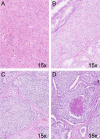Comedonecrosis Gleason pattern 5 is associated with worse clinical outcome in operated prostate cancer patients
- PMID: 34175896
- PMCID: PMC8514328
- DOI: 10.1038/s41379-021-00860-4
Comedonecrosis Gleason pattern 5 is associated with worse clinical outcome in operated prostate cancer patients
Abstract
Individual growth patterns and cribriform architecture are increasingly considered in risk stratification and clinical decision-making in men with prostate cancer. Our objective was to establish the prognostic value of individual Gleason 5 patterns in a radical prostatectomy (RP) cohort. We reviewed 1064 RPs and recorded Grade Group (GG), pT-stage, surgical margin status, Gleason 4 and 5 growth patterns as well as intraductal carcinoma. The clinical endpoints were biochemical recurrence and post-operative distant metastasis. Gleason pattern 5 was present in 339 (31.9%) RPs, of which 47 (4.4%) presented as primary, 166 (15.6%) as secondary, and 126 (11.8%) as tertiary pattern. Single cells/cords were present in 321 (94.7%) tumors with Gleason pattern 5, solid fields in 90 (26.5%), and comedonecrosis in invasive carcinoma in 32 (9.4%) tumors. Solid fields demonstrated either a small nested morphology (n = 50, 14.7%) or medium to large solid fields (n = 61, 18.0%). Cribriform architecture was present in 568 (53.4%) RPs. Medium to large solid fields and comedonecrosis coincided with cribriform architecture in all specimens, and were not observed in cribriform-negative cases. In multivariable analysis adjusted for Prostate-Specific Antigen, pT-stage, GG, surgical margin status and lymph node metastases, cribriform architecture (Hazard Ratio (HR) 9.9; 95% Confidence Interval (CI) 3.9-25.5, P < 0.001) and comedonecrosis (HR 2.1, 95% CI 1.2-3.7, P = 0.01) were independent predictors for metastasis-free survival, while single cells/cords (HR 1.2; 95% CI 0.7-1.8, P = 0.55) and medium to large solid fields (HR 1.6, 95% CI 0.9-2.7, P = 0.09) were not. In conclusion, comedonecrosis in invasive carcinoma is an independent prognostic Gleason 5 pattern for metastasis-free survival after RP. These data support the current recommendations to routinely include cribriform pattern in pathology reports and indicate that comedonecrosis should also be commented on.
© 2021. The Author(s).
Conflict of interest statement
The authors declare no competing interests.
Figures


Similar articles
-
Cribriform architecture in radical prostatectomies predicts oncological outcome in Gleason score 8 prostate cancer patients.Mod Pathol. 2021 Jan;34(1):184-193. doi: 10.1038/s41379-020-0625-x. Epub 2020 Jul 20. Mod Pathol. 2021. PMID: 32686748 Free PMC article.
-
Large cribriform growth pattern identifies ISUP grade 2 prostate cancer at high risk for recurrence and metastasis.Mod Pathol. 2019 Jan;32(1):139-146. doi: 10.1038/s41379-018-0157-9. Epub 2018 Oct 22. Mod Pathol. 2019. PMID: 30349027 Free PMC article.
-
Cribriform growth is highly predictive for postoperative metastasis and disease-specific death in Gleason score 7 prostate cancer.Mod Pathol. 2015 Mar;28(3):457-64. doi: 10.1038/modpathol.2014.116. Epub 2014 Sep 5. Mod Pathol. 2015. PMID: 25189638
-
The 2014 International Society of Urological Pathology (ISUP) Consensus Conference on Gleason Grading of Prostatic Carcinoma: Definition of Grading Patterns and Proposal for a New Grading System.Am J Surg Pathol. 2016 Feb;40(2):244-52. doi: 10.1097/PAS.0000000000000530. Am J Surg Pathol. 2016. PMID: 26492179 Review.
-
Prostate cancer with cribriform morphology: diagnosis, aggressiveness, molecular pathology and possible relationships with intraductal carcinoma.Expert Rev Anticancer Ther. 2018 Jul;18(7):685-693. doi: 10.1080/14737140.2018.1469406. Epub 2018 Apr 27. Expert Rev Anticancer Ther. 2018. PMID: 29699428 Review.
Cited by
-
Evaluating the effect of histopathological parameters of prostate adenocarcinoma on prognosis in radical prostatectomy specimens.Ann Saudi Med. 2024 Jul-Aug;44(4):234-248. doi: 10.5144/0256-4947.2024.234. Epub 2024 Aug 1. Ann Saudi Med. 2024. PMID: 39127900 Free PMC article.
-
Gleason Pattern 5 May Be a Prognostic Factor in Radium-223 Treatment.Cancer Diagn Progn. 2024 Jul 3;4(4):441-446. doi: 10.21873/cdp.10345. eCollection 2024 Jul-Aug. Cancer Diagn Progn. 2024. PMID: 38962543 Free PMC article.
-
The tumour histopathology "glossary" for AI developers.PLoS Comput Biol. 2025 Jan 23;21(1):e1012708. doi: 10.1371/journal.pcbi.1012708. eCollection 2025 Jan. PLoS Comput Biol. 2025. PMID: 39847582 Free PMC article. Review.
-
Accelerated growth and local progression of radiorecurrent prostate cancer in an orthotopic bioluminescent mouse model.Sci Rep. 2024 Dec 28;14(1):31205. doi: 10.1038/s41598-024-82546-w. Sci Rep. 2024. PMID: 39732766 Free PMC article.
-
Histopathological and Immunohistochemical Characterization of Sebaceous Adenoma and Epithelioma in Dogs.Animals (Basel). 2024 May 14;14(10):1457. doi: 10.3390/ani14101457. Animals (Basel). 2024. PMID: 38791674 Free PMC article.
References
-
- Gleason DF. Classification of prostatic carcinomas. Cancer Chemother Rep. 1966;50:125–8. - PubMed
-
- Epstein JI, Allsbrook WC, Jr, Amin MB, Egevad LL, Committee IG. The 2005 International Society of Urological Pathology (ISUP) Consensus Conference on Gleason Grading of Prostatic Carcinoma. Am J Surg Pathol. 2005;29:1228–42. - PubMed
-
- Epstein JI, Egevad L, Amin MB, Delahunt B, Srigley JR, Humphrey PA, et al. The 2014 International Society of Urological Pathology (ISUP) consensus conference on gleason grading of prostatic carcinoma: definition of grading patterns and proposal for a new grading system. Am J Surg Pathol. 2016;40:244–52. - PubMed
MeSH terms
Substances
LinkOut - more resources
Full Text Sources
Medical

